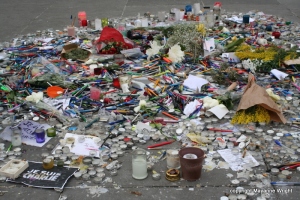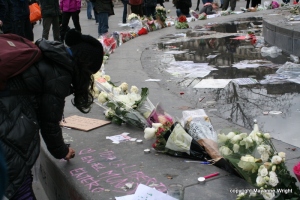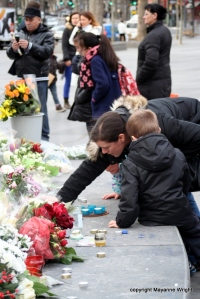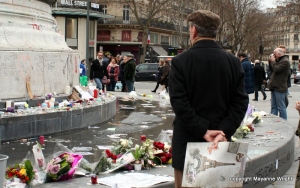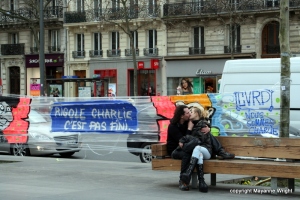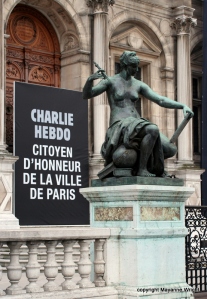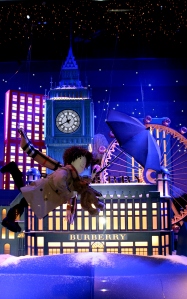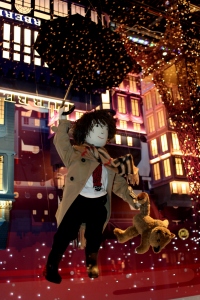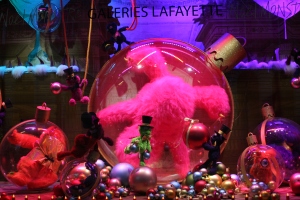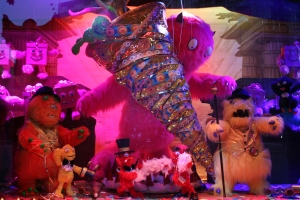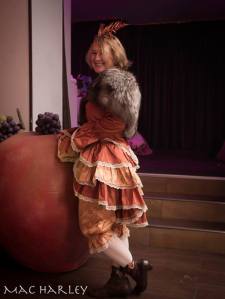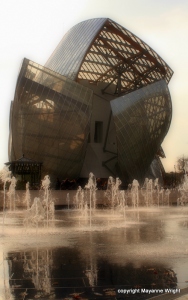 The Fondation Louis Vuitton rises up out of a verdant sea like a futuristic pirate ship at full sail. Glass and steel billow through the sky. Geometric shapes summersault over each other. Bold curves and quirky angles captivate my attention and cause my spirits to soar. The trials of a most difficult week evaporate in the face of such unbridled beauty and optimism. I gaze upward at Frank Gehry’s 2.5-story, 126,000 square foot architectural wonder until I become aware that the trio of Vigipirate soldiers patrolling the museum entrance have stopped and seem to be staring at me. I flash them a smile and hurry toward the end of the ticket line. It appears rather short for a Saturday, then a sign with the entry fee comes into sight: 14 euros. The sum would surpass the budget of many, especially if visiting en famille, and is higher than what it costs to visit most of Paris’s museums.
The Fondation Louis Vuitton rises up out of a verdant sea like a futuristic pirate ship at full sail. Glass and steel billow through the sky. Geometric shapes summersault over each other. Bold curves and quirky angles captivate my attention and cause my spirits to soar. The trials of a most difficult week evaporate in the face of such unbridled beauty and optimism. I gaze upward at Frank Gehry’s 2.5-story, 126,000 square foot architectural wonder until I become aware that the trio of Vigipirate soldiers patrolling the museum entrance have stopped and seem to be staring at me. I flash them a smile and hurry toward the end of the ticket line. It appears rather short for a Saturday, then a sign with the entry fee comes into sight: 14 euros. The sum would surpass the budget of many, especially if visiting en famille, and is higher than what it costs to visit most of Paris’s museums.
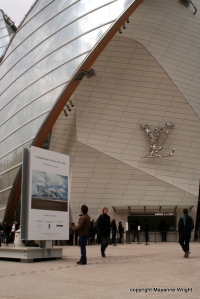 Built to one side of the Jardin d’Acclimation, a children’s amusement park on the west side of town where Marcel Proust once played, the Fondation Louis Vuitton is a contemporary art and culture center established by the LVMH (Louis Vuitton-Moët Hennessy) luxury-goods conglomerate. I purchase my ticket at a booth sitting just below a prominent silver sculpture of the company’s brand label. I then pass through a revolving door and metal detector into a vast open space. A bookstore and the entrance to the museum’s 11 galleries flank me to the left, a restaurant with white fish flying over diners lies to the front of me, signs indicating an auditorium beckon to the right. Which way to turn? In truth, I’ve come to see the building, not the rest.
Built to one side of the Jardin d’Acclimation, a children’s amusement park on the west side of town where Marcel Proust once played, the Fondation Louis Vuitton is a contemporary art and culture center established by the LVMH (Louis Vuitton-Moët Hennessy) luxury-goods conglomerate. I purchase my ticket at a booth sitting just below a prominent silver sculpture of the company’s brand label. I then pass through a revolving door and metal detector into a vast open space. A bookstore and the entrance to the museum’s 11 galleries flank me to the left, a restaurant with white fish flying over diners lies to the front of me, signs indicating an auditorium beckon to the right. Which way to turn? In truth, I’ve come to see the building, not the rest.
I opt for the auditorium first. I enter it from above and Ellsworth Kelly’s Spectrum VIII, a curtain of 12 colors showing a spectrum of colors, dominates the theatrical space. I take the stairs down to get a closer look, but the colors cannot compete with the building’s undulating glass windows and doors. They draw me to the exterior structure once more. I exit the auditorium onto a patio that leads to a reflecting pool that wraps around the building and a terraced waterfall. At any moment now, I expect to feel the swells of the ocean beneath my feet.
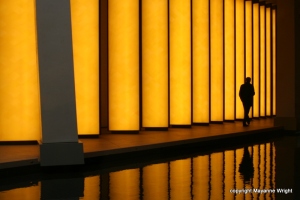 I then wander left to “the grotto” where I walk straight into Inside the Horizon (2014) by Olafur Eliasson, a contemporary Danish artist known for his monumental works. Within seconds, I find myself darting in and out of the 43 triangular columns curved along a colonnade opposite the museum building. Two sides of the columns consist of mirrors while the third is made of yellow glass and illuminated from within. I plunge into a narcissistic frenzy, taking multiple self-portraits in the mirrors. I gaze at myself with the curiosity of a child who has suddenly discovered her own reflection.
I then wander left to “the grotto” where I walk straight into Inside the Horizon (2014) by Olafur Eliasson, a contemporary Danish artist known for his monumental works. Within seconds, I find myself darting in and out of the 43 triangular columns curved along a colonnade opposite the museum building. Two sides of the columns consist of mirrors while the third is made of yellow glass and illuminated from within. I plunge into a narcissistic frenzy, taking multiple self-portraits in the mirrors. I gaze at myself with the curiosity of a child who has suddenly discovered her own reflection. 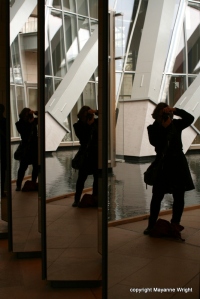 I snap photos of the parade of columns from every which angle, with people and without. My fascination could easily turn to addiction. But other visitors are doing the same, and our eyes meet in mutual reflection. Later I discover, that this is the artist’s intention. In this work, he wished to “question the horizon that separates perception and knowledge, imagination and expectations, the known and unknown, in each and everyone of us.” Bravo, Olafur! Mission accomplished.
I snap photos of the parade of columns from every which angle, with people and without. My fascination could easily turn to addiction. But other visitors are doing the same, and our eyes meet in mutual reflection. Later I discover, that this is the artist’s intention. In this work, he wished to “question the horizon that separates perception and knowledge, imagination and expectations, the known and unknown, in each and everyone of us.” Bravo, Olafur! Mission accomplished.
Drunk on imagination and the possible, I wander back into the “Iceberg”, the name given to the inner part of the building (Gehry calls the outer structure “La Verrière,” which roughly translates to “glass window or roof”). I float through the voluminous spaces of the other galleries, trying to focus on what I am actually seeing and experiencing. I fail. My heart belongs to the external structure of the museum. I run from one window to the next to study each nook and cranny. Finally, I realize that I have seen all I can from the inside. Time to venture out again. The exit lies opposite the entrance and leads into the Jardin d’Acclimation where I can get a full view of my new love. Inner child-fairy skipping from one end of the pirate ship to the other, I snap photographs, marvel at magnificence.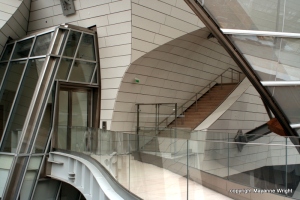
Then my camera battery dies. I notice my fingers have turned numb and decide to sit for a while in the sun, catch my breath, reorganize. I am heart-bursting happy. Beauty has that effect on me. One minute, I can be exhausted from stress, tension and conflict, ready to jump into the Seine and die, then I catch sight of something beautiful. I engage. I translate the experience into words and/or images. And then, suddenly, I feel fully alive, craving the next adventure, bursting with all-consuming joy. So, it was today. Thank you, Frank Gehry, for your genius and sharing it with us. Thank you—and I am trying not to say this grudgingly—Bernard Arnault, for spending some of your billions on art and culture. Thank you, Paris, for providing me a proper home.
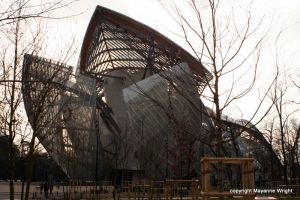
Frank Gehry, considered perhaps the greatest architect of our times, has created an architectural language all his own. Words rarely do justice to his works. Please click on the following link for a visual and descriptive overview of some of his better known works: http://www.architecturaldigest.com/architecture/2014-10/best-of-frank-gehry-slideshow_slideshow_item0_1
To learn more about Frank Gehry, the man and artist, watch these TED talks:
https://www.ted.com/talks/frank_gehry_asks_then_what
https://www.ted.com/talks/frank_gehry_as_a_young_rebel
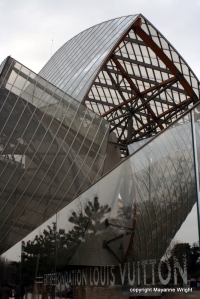
Bernard Arnault has been the chairman and CEO of LVMH, a luxury-goods empire of some 60 brands that include Dom Perignon, Kenzo, Sephora, De Beers, Givenchy, Guerlain, Moët et Chandon, Fendi, and Bulgari, since 1989. According to Forbes, he is the 13th richest man in the world, he and his family’s net worth coming in at some $36.6 billion. Mr. Arnault considers myself an ambassador of French culture and heritage (Forbes) and feels that the Gehry-designed museum is symbolic of who the people at LVMH are and what they do (Architectural Digest).
Sources other than the foundation website, those linked in the article, and my own experience:
http://www.lvmh.com
http://www.olafureliasson.net/
http://www.forbes.com/profile/bernard-arnault/
©2015, Mayanne Wright. All rights reserved.

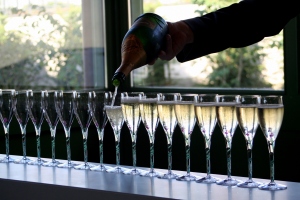
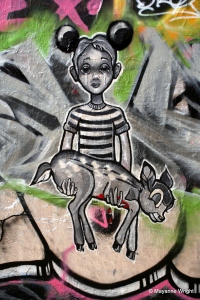
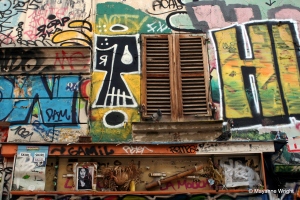
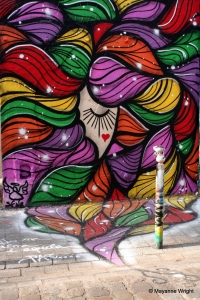
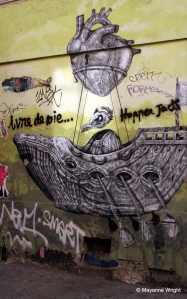








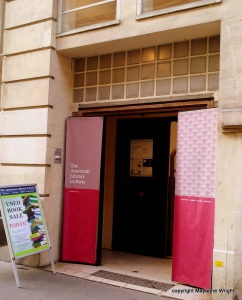
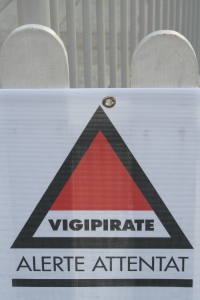
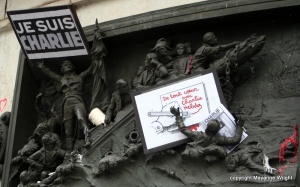 did we speak of the 12 individuals now dead, the shootout with the police in Paris’s streets, or the possible involvement of al-Qaeda. No, we discussed what would happen now, how the country would react. Already, countless individuals had changed their profile picture to “Je suis Charlie” and were decrying the assault against free speech and freedom of the press. We expressed our concern for France’s future. Most of all, we reassured ourselves that our lives would go on as before. Yes, we would have to take more precautions in the future, but damn it, we would not let those bastards get to us!
did we speak of the 12 individuals now dead, the shootout with the police in Paris’s streets, or the possible involvement of al-Qaeda. No, we discussed what would happen now, how the country would react. Already, countless individuals had changed their profile picture to “Je suis Charlie” and were decrying the assault against free speech and freedom of the press. We expressed our concern for France’s future. Most of all, we reassured ourselves that our lives would go on as before. Yes, we would have to take more precautions in the future, but damn it, we would not let those bastards get to us!